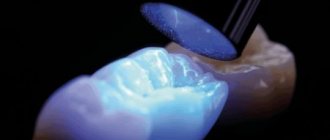What is the first thought that comes to your mind when looking at a photo where a shark’s teeth are exposed in an ominous grin?
Shark teeth are a wonderful tool that allows their owner to grab prey and hold it in the mouth, while large species of sharks can cut the victim's body in half as easily as a child bites off ice cream - piece by piece.
Not a single bone, even the thickest and strongest, can resist the multi-ton compression force of shark jaws, and the loss of several teeth will not bother the shark at all - the ocean predator's replaceable teeth grow throughout its life.
For comparison, the force of compression of the jaws of an adult Nile crocodile is about 1 ton per square centimeter, which is a lot in itself, but cannot be compared with the force of the jaws of a large shark.
You will notice, taking a closer look at the photo, that the teeth of a shark of one species differ from the teeth of individuals of another species - they are united only by their constant sharpness.
Sharks have teeth of a shape that allows them to securely grab their prey, tear off a large piece, or bite through its hard shell.
Photo of combtooth shark tooth
Photo of a whale shark tooth
Watch video - Deadly shark teeth:
Shark: description and photo. What does a shark look like?
There are over 500 different species of sharks. The superorder is characterized by a variety of sizes, shapes and other features. For example, the smallest deep-sea shark with a length of 17 cm is considered the smallest. One of the largest is the whale shark (up to 20 m in length). The same applies to weight - from 200 grams to several tens of tons.
Unlike bony fish, sharks have a skeleton made of cartilage tissue. At the same time, it is endowed with a sufficient level of rigidity. The skeleton includes 4 sections:
- spinal column (axial skeleton);
- unpaired fins;
- paired limbs (pelvic and pectoral fins);
- scull.
Anatomy of a shark
The maneuverability and speed of movement of a fish is ensured by several factors. The fish performs wave-like movements using its body, tail and fins. The tail fin, which includes two blades, serves as the main “engine” for the shark and also helps set the direction of movement. The fins located on the sides allow you to increase the speed of movement and perform maneuvers.
Shark tail fin
Each species of shark has certain anatomical features of its tail.
For example, a white shark moves very quickly, so its tail fin blades are almost identical. In other species, the upper lobe is larger than the lower one. Interesting fact : when a shark slows down, dives down or rises up, the paired fins along with the dorsal fins help it maintain balance. In this case, the fish is not able to swim in the opposite direction.
Dorsal fin of a shark
The body of sharks is covered with very strong placoid scales. Each scale is a diamond-shaped plate with a spike at the protruding end. Shark scales are called dermal denticles because they are similar to teeth in terms of strength and structure. The scales fit tightly to each other. Because of this, at first glance it seems that the skin is perfectly smooth and even. But if you run your hand over it in the opposite direction, from the tail to the head, a rough effect immediately becomes noticeable - the skin feels like sandpaper to the touch.
Shark skin under a microscope
The musculature of a shark is represented by several muscle groups:
- cardiac;
- somatic (red and white, responsible for body movement);
- visceral (muscles in blood vessels and internal organs).
The body of sharks is quite simple, and the metabolism is slow. Because of this, they cannot undergo prolonged physical activity. As a result of intense activity, excessive amounts of lactic acid accumulate in the body, which can negatively affect internal processes.
Sharks breathe oxygen from the water through their gills. The role of their respiratory organs is performed by the gill slits. They are located in front of the pectoral fins. The number of slits depends on the type of shark - from 5 to 7 pairs.
Shark gill slits
Due to the work of the heart, blood in sharks is transported through the gill artery into the vessels that are located in the gills. There the blood is saturated with oxygen and sent to the organs. However, blood pressure is not enough to supply the entire body with enough oxygen. Therefore, the shark is in constant motion - muscle contraction increases blood flow.
Bony fish have a swim bladder filled with gas. Sharks do not have it, so buoyancy is provided by the huge liver, as well as the skeleton and fins. And sand sharks imitate a swim bladder, filling the stomach with air.
Most sharks are cold-blooded with the exception of about 8 species. In white, blue and other sharks, certain parts of the body have a higher temperature than the environment. This allows them to move faster in cold water. Active muscle work contributes to an increase in temperature.
The stomach of sharks is U-shaped and can easily stretch. The liver occupies about 30% of the volume of the entire body. In addition to participating in buoyancy processes, it serves as a kind of storage facility, which contains useful substances and energy reserves.
The shark spends its accumulated resources for a very long time and gradually after eating, so it is capable of starving for a long time. For example, a shark weighing 150 kg requires about 80-90 kg of fish per year. From time to time, fish have to empty their stomachs of food debris. To do this, they turn it out through the mouth without causing absolutely any damage to the teeth.
For sharks, the main sensory system is a well-developed sense of smell. They are excellent at distinguishing odors by passing water through their nostrils to the receptors.
Interesting fact : some sharks have such sensitive receptors that they recognize the smell of blood in a ratio of 1 to 1 million. That is, they are able to sense it at a great distance, dissolved in a large mass of water.
The vision of some fish species is characterized by increased acuity. In addition, they are able to distinguish small details and some colors. Perception frequency – 45 frames per second. Some species have blinking eyelids, others do not. To protect their eyes from damage, the second type of shark rolls them up during an attack.
Shark eyes and nostrils
The organ of hearing is the inner ear, located inside the cartilaginous capsule. Predatory fish are able to detect low-frequency sounds and infrasound. The ear also helps maintain balance.
Interesting fact : the white shark has the best hearing among sharks.
Sharks have a sensitive organ - the lateral line, which runs inside the skin along the side of the body. It reacts to water fluctuations and allows fish to navigate in space, hunt and perform other vital functions.
Shark lateral line
Viper shark
The pit viper shark has triangular-shaped jaws and needle-like teeth. (Image credit: Hsuan-Ching Ho)
The viper shark (Trigonognathus kabeyai) may well be from another planet. This species of deep sea shark was only discovered in 1986 and has rarely been seen since. Like goblin sharks, viper sharks also have a protruding jaw with a nasty set of scruffy teeth. But these scary-looking creatures are not that big – viper sharks only grow to 18–53 centimeters in length.
The Viper Shark also glows. Bioluminescent organs called photophores line the underside of these sharks. The pit viper shark is part of the glow shark family (Etmopteridae), all members of which glow. This glow likely camouflages the sharks when viewed from below, as the subtle glow blends with the sunlight filtering through the water. The light can also attract small prey in the dark ocean depths.
How many teeth does a shark have?
The shape, size and number of teeth depend on what kind of life the shark leads and what it eats. Teeth are the main weapon of these predators and their growth continues throughout the entire life cycle of the fish. This is nothing more than modified placoid scales covering the skin.
Interesting: Puffer fish











